
How to Use 1 Channel 5V Relay Module: Examples, Pinouts, and Specs
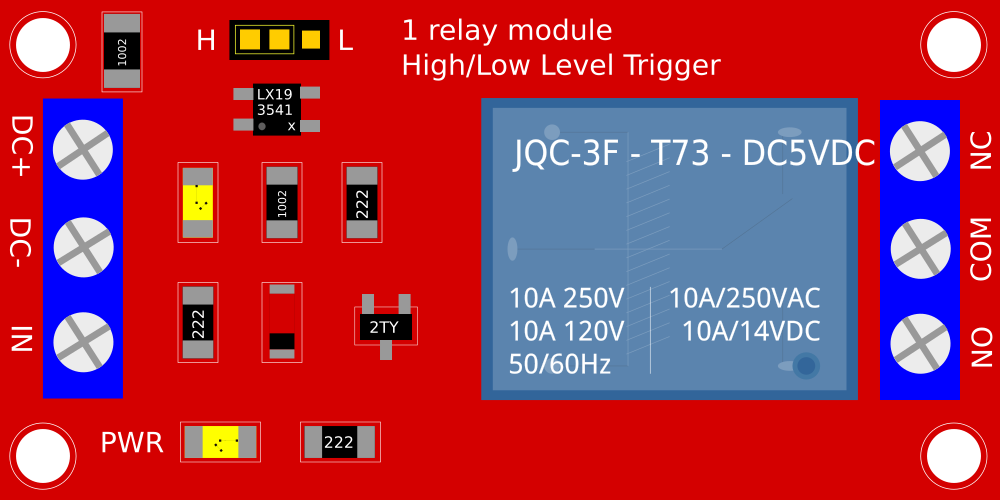
 Design with 1 Channel 5V Relay Module in Cirkit Designer
Design with 1 Channel 5V Relay Module in Cirkit DesignerIntroduction
The 1 Channel 5V Relay Module is an electronic component designed to allow a low-voltage control signal (e.g., from a microcontroller) to switch a higher voltage circuit. This module is widely used in applications where electrical isolation and control of high-power devices are required. It is ideal for controlling devices such as lights, fans, motors, and other appliances.
Explore Projects Built with 1 Channel 5V Relay Module
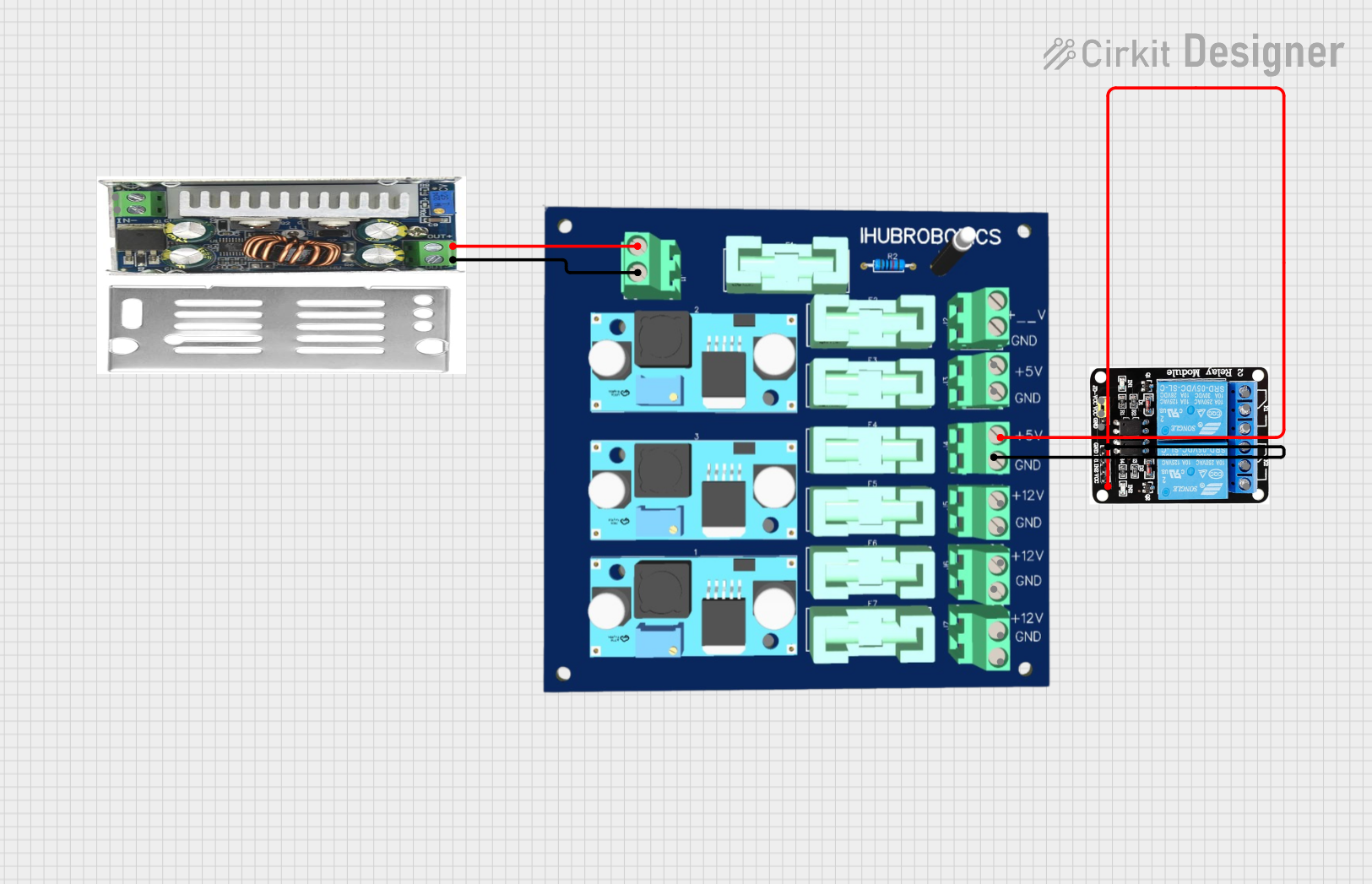
 Open Project in Cirkit Designer
Open Project in Cirkit Designer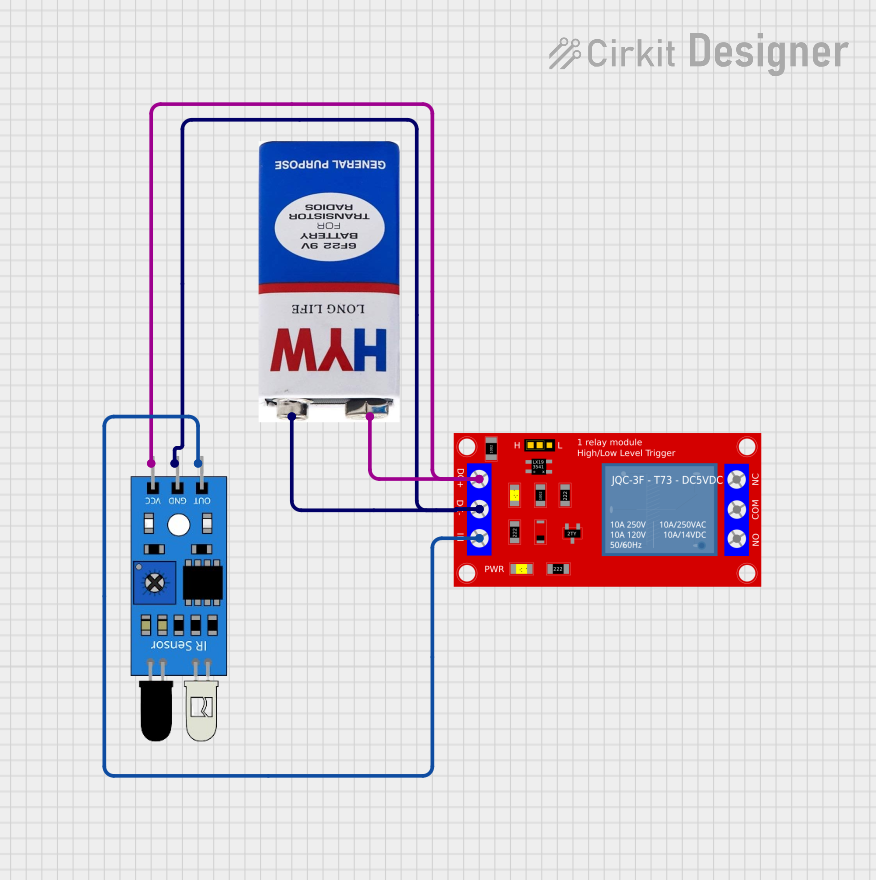
 Open Project in Cirkit Designer
Open Project in Cirkit Designer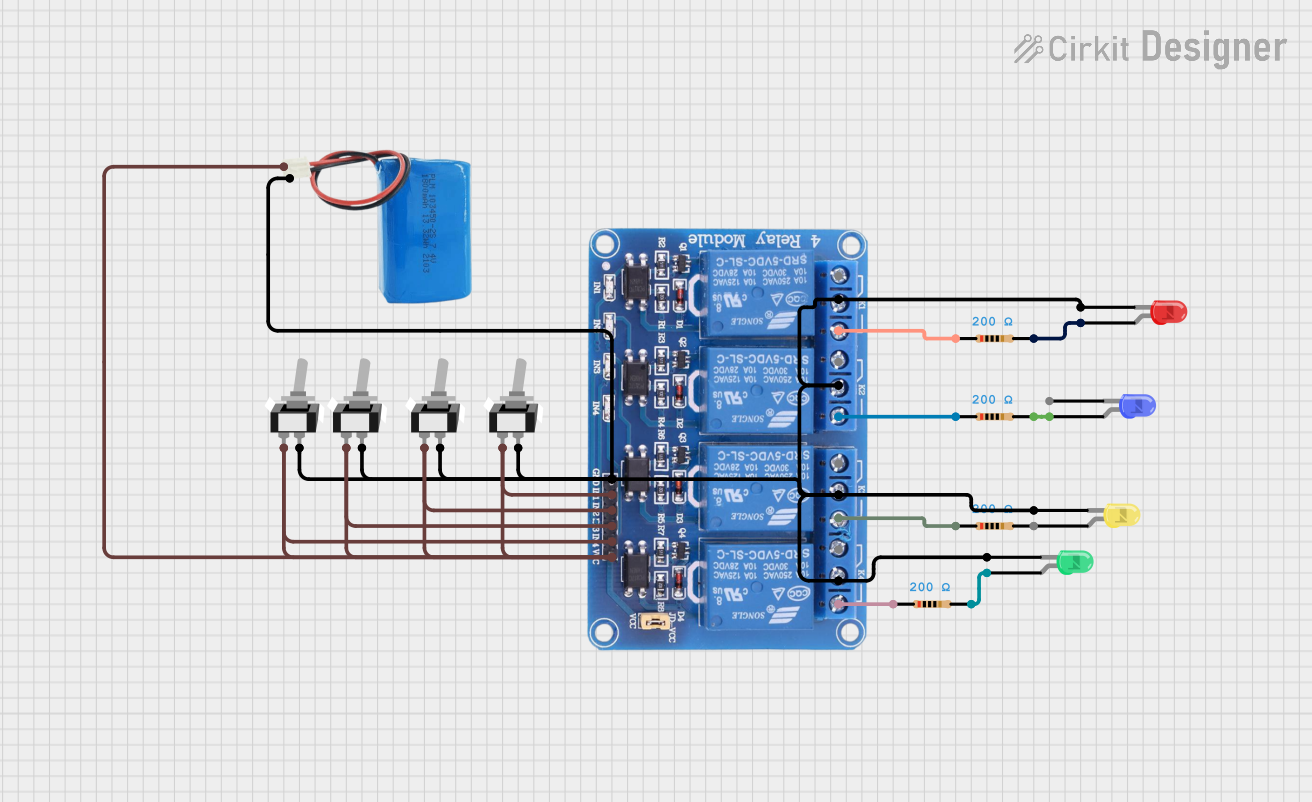
 Open Project in Cirkit Designer
Open Project in Cirkit Designer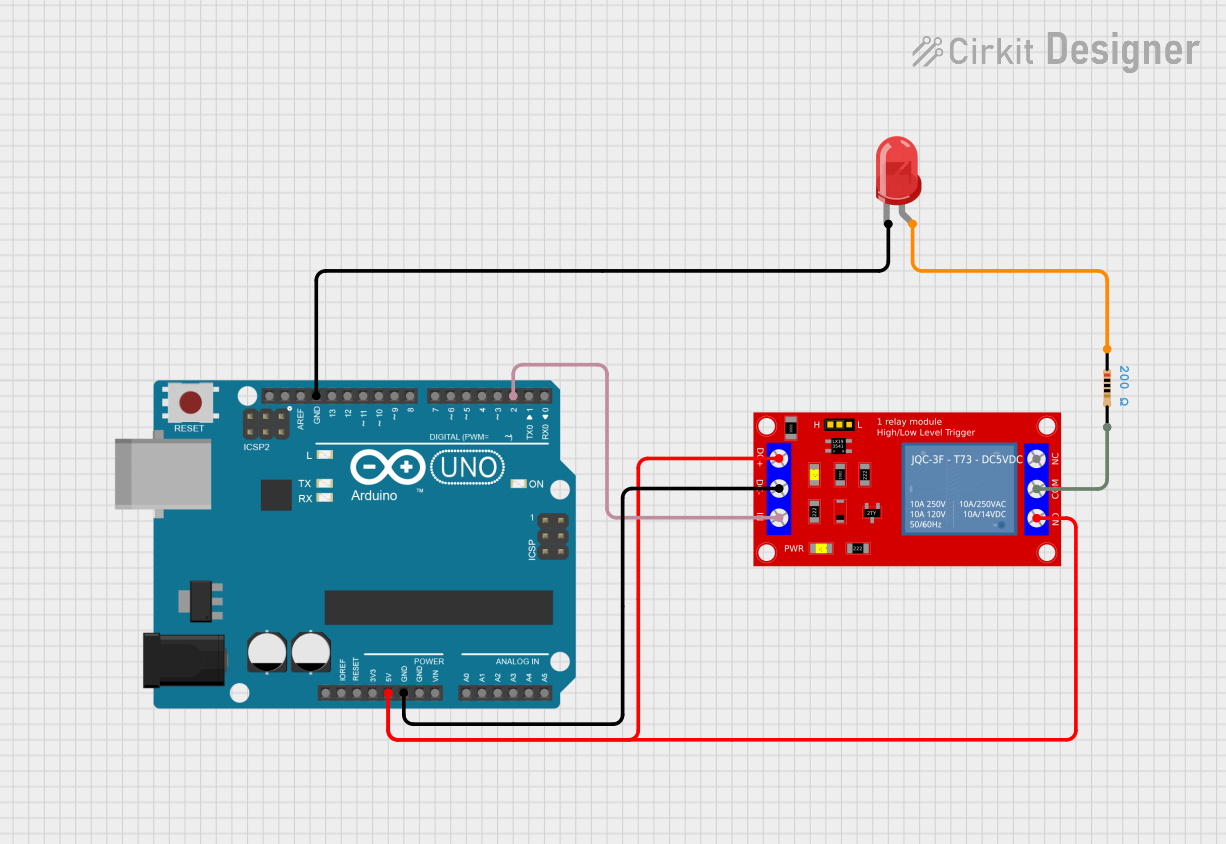
 Open Project in Cirkit Designer
Open Project in Cirkit DesignerExplore Projects Built with 1 Channel 5V Relay Module

 Open Project in Cirkit Designer
Open Project in Cirkit Designer
 Open Project in Cirkit Designer
Open Project in Cirkit Designer
 Open Project in Cirkit Designer
Open Project in Cirkit Designer
 Open Project in Cirkit Designer
Open Project in Cirkit DesignerCommon Applications and Use Cases
- Home automation systems
- Industrial control systems
- IoT projects for switching high-power devices
- Motor control in robotics
- Smart lighting systems
Technical Specifications
The following are the key technical details of the 1 Channel 5V Relay Module:
| Parameter | Value |
|---|---|
| Operating Voltage | 5V DC |
| Trigger Voltage | 3.3V to 5V DC |
| Maximum Load Voltage | 250V AC / 30V DC |
| Maximum Load Current | 10A |
| Relay Type | SPDT (Single Pole Double Throw) |
| Isolation | Optocoupler isolation |
| Dimensions | ~50mm x 26mm x 18mm |
| Indicator LED | Yes (lights up when the relay is active) |
Pin Configuration and Descriptions
The module has a total of 6 pins and terminals, as described below:
Input Pins
| Pin Name | Description |
|---|---|
| VCC | Connect to 5V DC power supply |
| GND | Ground connection |
| IN | Control signal input (3.3V or 5V logic level) |
Output Terminals
| Terminal Name | Description |
|---|---|
| COM | Common terminal for the relay switch |
| NO | Normally Open terminal (connected to COM when |
| the relay is activated) | |
| NC | Normally Closed terminal (connected to COM |
| when the relay is not activated) |
Usage Instructions
How to Use the Component in a Circuit
- Power the Module: Connect the VCC pin to a 5V DC power supply and the GND pin to the ground.
- Control Signal: Connect the IN pin to a digital output pin of a microcontroller (e.g., Arduino UNO). The relay will activate when the control signal is HIGH.
- Connect the Load:
- Connect the device you want to control (e.g., a light bulb) to the COM and NO terminals if you want it to turn on when the relay is activated.
- Alternatively, connect the device to the COM and NC terminals if you want it to turn off when the relay is activated.
- Isolation: Ensure proper electrical isolation between the low-voltage control circuit and the high-voltage load circuit.
Important Considerations and Best Practices
- Safety First: Always ensure the high-voltage side of the circuit is properly insulated to avoid electric shock.
- Current Rating: Do not exceed the maximum current rating of 10A to prevent damage to the relay.
- Flyback Diode: If controlling an inductive load (e.g., a motor), use a flyback diode across the load to protect the relay from voltage spikes.
- Logic Level Compatibility: Ensure the control signal voltage matches the relay's trigger voltage (3.3V or 5V).
Example: Connecting to an Arduino UNO
Below is an example of how to use the 1 Channel 5V Relay Module with an Arduino UNO to control a light bulb.
Circuit Connections
- Connect the relay module's VCC to the Arduino's 5V pin.
- Connect the relay module's GND to the Arduino's GND pin.
- Connect the relay module's IN pin to Arduino digital pin 7.
- Connect the light bulb to the COM and NO terminals of the relay module.
- Connect the other side of the light bulb to the AC power supply.
Arduino Code
// Define the relay control pin
const int relayPin = 7;
void setup() {
// Set the relay pin as an output
pinMode(relayPin, OUTPUT);
// Ensure the relay is off at startup
digitalWrite(relayPin, LOW);
}
void loop() {
// Turn the relay on (light bulb ON)
digitalWrite(relayPin, HIGH);
delay(5000); // Keep the light on for 5 seconds
// Turn the relay off (light bulb OFF)
digitalWrite(relayPin, LOW);
delay(5000); // Keep the light off for 5 seconds
}
Troubleshooting and FAQs
Common Issues and Solutions
Relay Not Activating:
- Cause: Insufficient control signal voltage.
- Solution: Ensure the IN pin receives a voltage of at least 3.3V (logic HIGH).
Load Not Switching:
- Cause: Incorrect wiring of the load to the relay terminals.
- Solution: Double-check the connections to the COM, NO, and NC terminals.
Relay Clicking but No Output:
- Cause: Faulty relay or insufficient power supply.
- Solution: Verify the power supply voltage and current. Replace the relay if necessary.
Indicator LED Not Lighting Up:
- Cause: No power to the module or damaged LED.
- Solution: Check the VCC and GND connections. Replace the module if the LED is damaged.
FAQs
Q1: Can I use this relay module with a 3.3V microcontroller like the ESP8266?
A1: Yes, the relay module can be triggered with a 3.3V control signal. Ensure the VCC pin is still powered with 5V.
Q2: Can I control DC devices with this relay?
A2: Yes, the relay can switch DC devices as long as the voltage does not exceed 30V and the current does not exceed 10A.
Q3: Is the relay module safe for switching high-power AC devices?
A3: Yes, but ensure proper insulation and follow safety guidelines when working with high-voltage circuits.